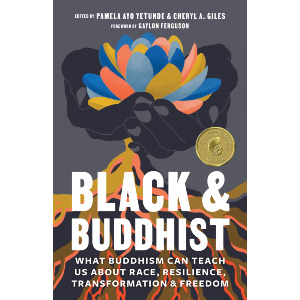By Pamela Ayo Yetunde
November 2, 2020
Cheryl and I, like you, live in interlocking and interdependent cultural worlds. We are cis-gender women of African descent living in the U.S. We are Buddhist practitioners and we are also in same-gender-loving relationships. Cheryl is a psychologist and I am a pastoral counselor. We teach in higher education institutions and we also engage in clinical counseling. We write and we advocate. We interact with Buddhists and non-Buddhists, men, and different-gender-loving people. White people and people from other countries make up parts of our families and communities. It is fair to say that our communities are rich, interwoven tapestries of differences and similarities that inform how we teach, how we practice, and how we live. Arguably, we have not had the privilege to avoid being and doing otherwise, but we know many of our peers have used their privilege to avoid working on becoming more culturally-competent teachers. In this essay, we hope to encourage you, no matter your profession or vocation, to use difference to build and sustain yourself, family, and community, but with respect to and for dharma teachers, we encourage you to embrace the belief that working on cultural competency is an ethical imperative that began with the Buddha.
According to a Buddha story, when the Buddha believed he could not teach what he had learned through his awakening because he believed people were not capable of understanding his experience, he created a dichotomy between him and everyone else. He suffered in his dichotomous thinking and thought the way out of his suffering was to seclude himself from others. The impulse towards deep introversion was so painful that a deity appeared to assure him that people would understand. This heavenly intervention encouraged the Buddha, so he proceeded to teach.
The Buddha was afflicted with a cultural incompetency that some Buddhist teachers have also been or are afflicted with—the belief that no one will understand or only certain people will understand what we have experienced—so we talk only to those we believe will understand. Keeping to the familiar is like incarcerating oneself in a pedagogical prison, locking teachers and students into a feedback loop that reifies the culture already in place. But the Buddha, though initially insecure, didn’t stay in place only teaching people he knew—he traveled and listened to others from their cultural contexts.
In the Pali Canon, it is said that the Buddha and his disciples traveled from grove to grove, often encountering people of different belief systems. It is also said that when the Buddha was challenged by someone from a different belief system, he did not brow beat them by consistently repeating the same lessons over and over again until they got it (or left in frustration), but used parables to illustrate a point. These parables, like parables in other traditions, draw on our common humanity—the ability to be empathetic, compassionate, and insightful. When we think about striving towards cultural competency, we need to remember that we all have some things in common, that some things are different, and that each one of us is a unique individual. Many monastic communities create cultures of similarity in dress, customs, and mentality to help deepen an adherent’s spiritual life. Dharma teachers would do well to examine whether the ways they teach lay people are unconsciously (or consciously) promoting sameness and whether promoting sameness serves the ever growing diversity of Buddhist practitioners in the U.S. This dynamic of diversity in the culture of sameness has been under scrutiny for some time.
Buddhist practitioner and religion professor Jan Willis wrote about Buddhism and race in 1996 (or earlier), and also wrote the first edition of Dreaming Me in 2001. Not long ago I (Ayo) heard Zen priest Rev. angel Kyodo williams talk about her book being black: Zen and the Art of Living with Fearlessness and Grace (2000). About being black, Williams said she wanted to invite Black people into Zen communities, but she had to co-author (along with Black and Buddhist contributor Lama Rod Owens (author of Love and Rage (2020), and Dr. Jasmine Syedullah) Radical Dharma: Talking Race, Love, and Liberation in 2016 to help Zen and other dharma communities become truly welcoming of Black people. Apparently it takes more than two books, 16 years, and three Black people to realize cultural competency in Buddhist communities. Black and Buddhist contributor Ruth King published Mindful of Race in 2018 and founded the Mindful of Race Institute in 2020. Think about these authors, titles, and initiatives from a cultural competency perspective. In decades of Black Buddhist writers coming in and out of dharma communities, there was and to our knowledge still is no sangha-wide imperative that dharma teachers be culturally competent in their teaching. Could it be that the dharma is perceived as asking us to check our culture at the dharma gates? Do dharma leaders see themselves as dharma gate keepers, keeping another’s culture from disturbing the peace of mind practitioners come for when they gather for sangha? It depends on who you ask.
Dharma teacher pioneer Larry Yang, author of Awakening Together in 2017, co-wrote “Making the Invisible, Visible” in 2000 and it remains a relevant resource. Zen priest and editor Hilda Gutierrez Baldoquin published essays in Dharma, Color, and Culture: New Voices in Western Buddhism, 2004, and it remains a relevant resource. Black and Buddhist contributor, Sebene Selassie, our favorite “nerdy Black immigrant tomboy Buddhist weirdo” makes the case for belonging in her 2020 book, You Belong, but belonging is always supported by a teacher’s radical acceptance of a student’s culture.
At least from the late 1990s to now when we are releasing Black and Buddhist: What Buddhism Can Teach Us About Race, Resilience, Transformation and Freedom, dharma teachers across the board still do not have an imperative for being culturally competent, even though it is said that the Buddha attempted to be culturally astute. What might wrapping ourselves in the Buddha’s teachings, as Zen practitioners chant, look like as we struggle with our own beliefs that only certain people will understand the dharma? Perhaps a dose of pedagogical humility.
We are not the historical Buddha, burdened with an experience whereby we dichotomize to such a degree that we need a deity to save us. There is nothing we know from practice that no one else can know. No one’s culture precludes them from awakening, and as Zenju Earthlyn Manuel states in her book The Way of Tenderness: Awakening Through Race, Sexuality, and Gender (2015), culture is a dharma gate, and being skilled in dharma teaching within the cultural dharma gate(s) that people bring to sangha can only really happen if we, as dharma teachers, are willing to be dharma students to those who enter our sanghas. Yes, we must flip the switch and be, paradoxically, students as we teach.
We live in interlocking and interdependent cultural worlds. We interact with Buddhists, non-Buddhists, and people of multiple religious identities and belonging. White people and people from other countries make up parts of our selves, families, and communities. We eschew our privileges to permanently segregate ourselves to dwell in the comfort of undisrupted cultural feedback loops because doing so doesn’t produce liberation, or freedom, or joy. In fact, undisrupted cultural feedback loops produce cultural ignorance. Many individuals for decades have advocated for cultural competency in teaching. They have met many times, created resources that are still available and instructive, written articles, essays, and books that are still available and relevant, and have convened in small and large venues. The next logical step in the creation of a mahasangha (Buddhist communities across traditions) that truly embraces the actuality of awakening through culture would be for communities to insist that their teachers and teachers in training be on the path to cultural competency through pedagogical humility. We hope Black and Buddhist: What Buddhism Can Teach Us about Race, Resilience, Transformation, and Freedom, will serve as another tool toward cultural competency in Buddhist communities.
Share
PAMELA AYO YETUNDE, J.D., Th.D. is a Community Dharma Leader in the Insight Meditation tradition. She teaches pastoral care and counseling and has taught at University of the West, United Theological Seminary of the Twin Cities, and Upaya Institute and Zen Center. Ayo has written for Buddhadharma, Lion's Roar, religions, and Buddhist-Christian Studies. She is the author of Object Relations, Buddhism and Relationality in Womanist Practical Theology, and Buddhist-Christian Dialogue, U.S. Law, and Womanist Theology for Transgender Spiritual Care.



